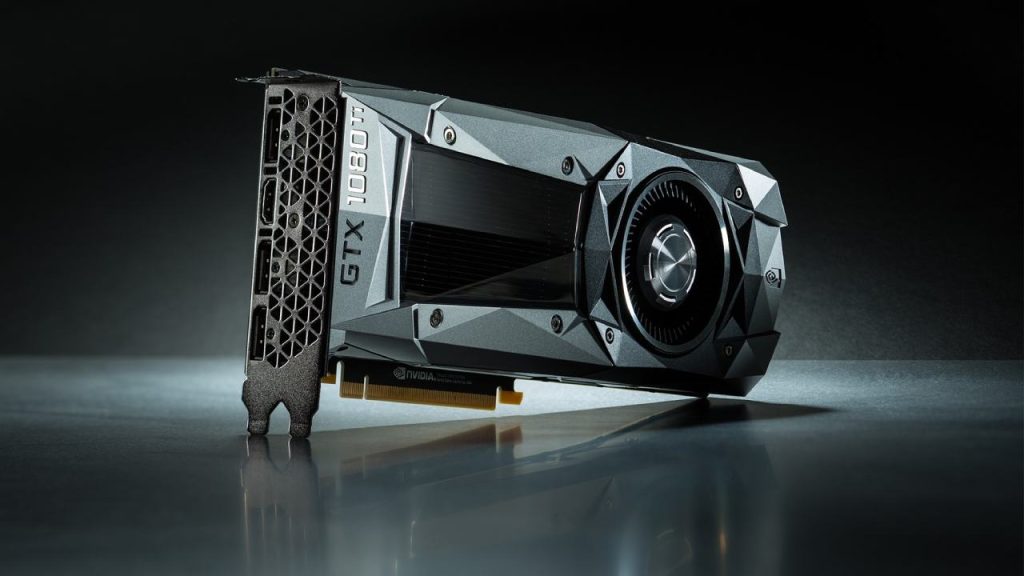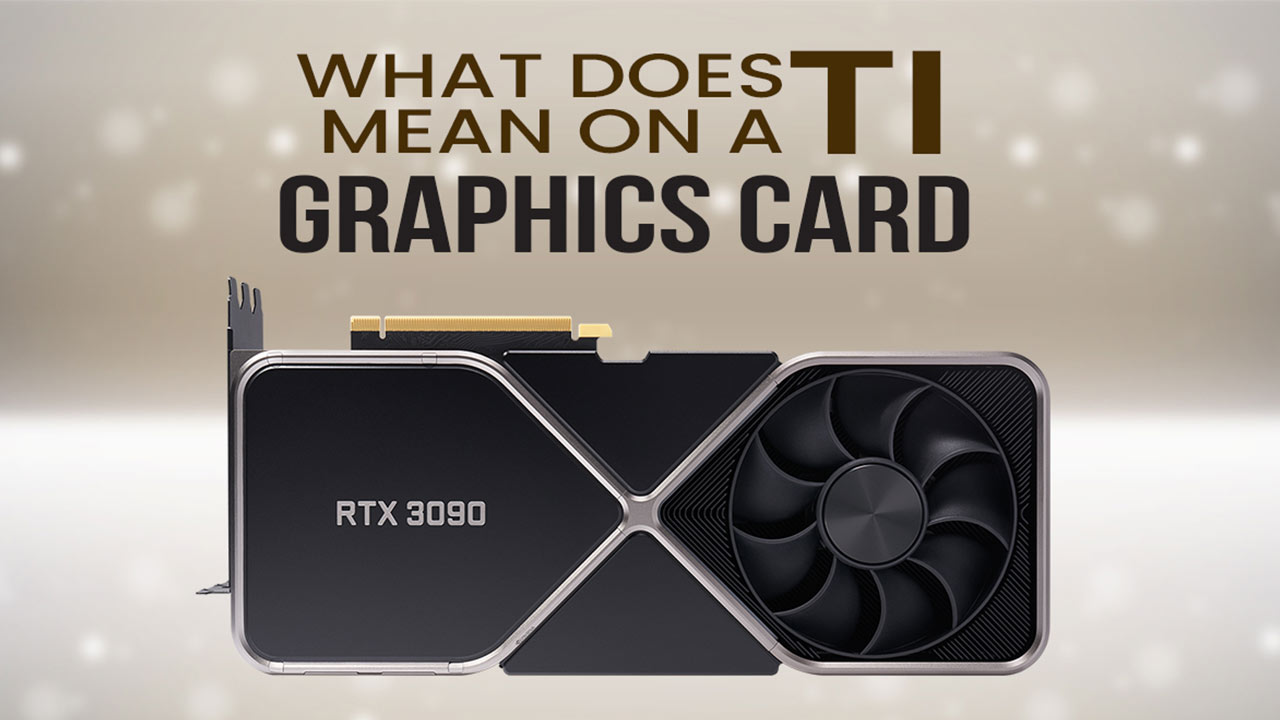The term “Ti” was coined by Nvidia, which the company uses to name its graphics cards, i.e. Nvidia RTX 3060Ti.
“Ti” stands for “Titanium” and is added at the end of the name of an Nvidia GPU to represent that the product is a more powerful variant of the base model.
You are likely to have come across the Ti variants of GPUs if you have ever planned on building a gaming PC. This can be confusing to a lot of people as they come across two GPUs of the same lineup but with a slightly different name. AMD, who is the fiercest competitor of Nvidia, is also guilty of following this rather unusual naming scheme, i.e. AMD RX 5700 and RX 5700 XT.
In this article, we are going to be talking about what “Ti” actually means, how GPUs with “Ti” differ from their base forms, and whether you should invest in these types of graphics cards. Let’s get the ball rolling.
What Does Ti Mean On A Graphics Card? An Overview
Although the abbreviated term “Ti” means “Titanium”, Nvidia’s Ti line of cards doesn’t actually have any titanium in them.
The company introduced Ti graphics cards to compete with AMD’s graphics cards in terms of price and performance. Usually, Nvidia releases its Ti variant of cards after the base model. These cards are known to have better specs than the base cards.
There is a catch here. Though the Ti version is better than the base model, they are not as powerful as the upper-tier card. For example, RTX 3060Ti is more powerful than the RTX 3060. But it is not as powerful as an RTX 3070.
Ti vs Non-Ti GPUs: Spec Comparison
Now, let’s get into the technical side of things. Here, we are going to be comparing the Ti GPUs against the non-Ti GPUs to see how they stack up in terms of specs.
For our comparison, we are going to be taking a look at Nvidia’s RTX 3000 series of GPUs.
| GPU Engine Specs: | RTX 3090 Ti | RTX 3090 | RTX 3080 Ti | RTX 3080 | RTX 3070 Ti | RTX 3070 | RTX 3060 Ti | RTX 3060 |
| NVIDIA CUDA® Cores | 10752 | 10496 | 10240 | 8960 / 8704 | 6144 | 5888 | 4864 | 3584 |
| Boost Clock (GHz) | 1.86 | 1.7 | 1.67 | 1.71 | 1.77 | 1.73 | 1.67 | 1.78 |
| Base Clock (GHz) | 1.67 | 1.4 | 1.37 | 1.26 / 1.44 | 1.58 | 1.5 | 1.41 | 1.32 |
| Standard Memory Config | 24 GB GDDR6X | 24 GB GDDR6X | 12 GB GDDR6X | 12 GB GDDR6X / 10 GB GDDR6X | 8 GB GDDR6X | 8 GB GDDR6 | 8 GB GDDR6 / 8 GB GDDR6X | 12 GB GDDR6 / 8 GB GDDR6 |
| Memory Interface Width | 384-bit | 384-bit | 384-bit | 384-bit / 320-bit | 256-bit | 256-bit | 256-bit | 192-bit / 128-bit |
From the table, it should be quite evident how Ti models differ from their non-Ti counterparts. For instance, the RTX 3090 Ti has a higher base clock, a higher boost clock, and more CUDA cores.
On the other hand, both GPUs have the same memory configuration and width.
Ti vs Non-Ti GPUs: Benchmarks
Next, we decided to benchmark all the 3000 series GPUs against one another to see how they compare for creative workloads.
For our test, we used programs like Geekbench 5 and Blender to see the performance differences. Also, we repeated the test a total of 5 times for each GPU to get the average score.
Here are the results:
| Graphics Card | Geekbench 5 OpenCL Score |
| RTX 3090Ti | 241103 |
| RTX 3080 (12GB) | 229279 |
| RTX 3090 | 222728 |
| RTX 3080Ti | 217965 |
| RTX 3080 (10GB) | 198571 |
| RTX 3070Ti | 157921 |
| RTX 3070 | 144713 |
| RTX 3060Ti | 129040 |
| RTX 3060 | 104232 |
The information we get from this table is rather interesting. Let’s get the obvious out of the way first – from the RTX 3060 to the RTX 3090Ti, as well as the RTX 3090Ti, the Geekbench 5 OpenCL scores seem to be in line with how powerful each of these cards is.
But here the outlier is the RTX 3080 12GB variant as it scores much higher than even the RTX 3080Ti and RTX 3090. So, let’s see some other results to determine if this anomaly is true.
| Graphics Card | Geekbench 5 Vulkan Score |
| RTX 3090Ti | 158233 |
| RTX 3080Ti | 143099 |
| RTX 3080 (10 GB) | 133092 |
| RTX 3080 (12 GB) | 130618 |
| RTX 3090 | 127913 |
| RTX 3070Ti | 117751 |
| RTX 3070 | 110873 |
| RTX 3060Ti | 106337 |
| RTX 3060 | 82501 |
The results here are just as strange as the last time. In our Geekbench 5 Vulkan benchmark, all the RTX 3080 cards are outperforming the RTX 3090. Moreover, the 10GB RTX 3080 is also outperforming the 12 GB RTX 3080.
Next, let’s look at how these GPUs perform on Blender.
| Graphics Card | Blender 3.1 Score |
| RTX 3090Ti | 2990.9 |
| RTX 3090 | 2781.1 |
| RTX 3080Ti | 2773.7 |
| RTX 3080 (12 GB) | 2444.9 |
| RTX 3080 (10 GB) | 2337.4 |
| RTX 3070Ti | 1794.3 |
| RTX 3070 | 1716.5 |
| RTX 3060Ti | 1508.7 |
| RTX 3060 | 1201.3 |
Since Blender is a more graphically intensive benchmark, the scores line up how they are supposed to for the RTX 3000 series GPUs.
Overall, if you want to be on the safe side, then going for the RTX 3060, 3060Ti, 3070, 3070Ti, or 3090Ti would be a safe option as it always falls in line with how they are supposed to perform. But benchmarks aren’t the be all end all of things. So, let’s check out another metric!
Ti vs Non-Ti GPUs: Gaming Performance
Now it’s time to play some games using these graphics cards! We will see how each of these cards holds up in some of the most demanding games. For the presets, we put the resolution at 1440p and set everything to ultra. Here are the FPS counts!
| Graphics Card | Plague Tale: Requiem | Uncharted 4 | Spiderman Remastered | COD: MW 2 (2022) | Days Gone | Resident Evil Village | Cyberpunk 2077 | Horizon Zero Dawn | Red Dead Redemption 2 |
| RTX 3090Ti | 72 | 164 | 201 | 151 | 173 | 209 | 126 | 100 | 145 |
| RTX 3090 | 65 | 151 | 184 | 140 | 160 | 196 | 118 | 94 | 137 |
| RTX 3080Ti | 63 | 148 | 179 | 137 | 158 | 192 | 115 | 92 | 133 |
| RTX 3080 | 57 | 137 | 164 | 128 | 147 | 179 | 103 | 84 | 124 |
| RTX 3070Ti | 50 | 129 | 153 | 121 | 140 | 171 | 97 | 77 | 116 |
| RTX 3070 | 46 | 122 | 144 | 113 | 133 | 164 | 89 | 70 | 107 |
| RTX 3060Ti | 40 | 113 | 135 | 104 | 127 | 155 | 82 | 63 | 98 |
| RTX 3060 | 29 | 94 | 110 | 87 | 112 | 139 | 69 | 49 | 81 |
Using the information provided, we can see that the Ti versions offer a nice boost in FPS. But in most cases, it is not a huge bump. For instance, the FPS difference between a RTX 3080 and a 3070 is approximately 15 FPS. Whereas, the FPS difference between a RTX 3070Ti and a 3070 is around 7 FPS. The only significant boost is between the RTX 3060 and 3060Ti, hence it can be a great entry-level card for both gaming and productivity tasks.
Factors To Consider When Buying A Graphics Card
Before you decide whether you want to buy a Ti or a non-Ti GPU, here are some of the aspects that you need to consider.
- Performance: The most important factor is the performance of the GPU, which is determined by its specifications, such as the number of cores, clock speed, and memory bandwidth. Ti version cards have a higher number of cores and clock speed, but the memory bandwidth remains the same as the base model. So, you can expect to get slightly improved performance from them.
- Compatibility: Ensure the GPU is compatible with your system and meets the requirements for the applications you plan to run. Hence, it is recommended to check your motherboard before you get a graphics card to see if it will support it or not.
- Power Consumption: High-performance GPUs consume more power, so consider the power supply and cooling capabilities of your system.
- Memory: The amount of memory on a GPU affects its performance and the size of the textures it can handle in demanding applications. Generally, Ti graphics cards have the same amount of memory as their base unit.
- Price: GPU prices can vary greatly based on their specifications, brand, and model, so consider your budget when making a purchase. This is especially true for Ti cards as they are more expensive than the base model due to them being more powerful.
- Brand and Warranty: Consider the reputation of the brand and the warranty offered with the GPU, as this can impact the overall value and longevity of your purchase. Go for brands like Asus, MSI, Gigabyte, EVGA, ASRock, etc.

Should You Consider Getting A Ti Graphics Card?
All things considered, Ti graphics cards can be a great option to consider if you are not satisfied with Nvidia’s base cards. However, keep in mind the price-to-performance ratio as they are going to provide you with a moderate performance boost.
Overall, Nvidia has done a great job in offering its customers with GPUs of all tiers so that you can choose one as per your gaming and productivity needs.







